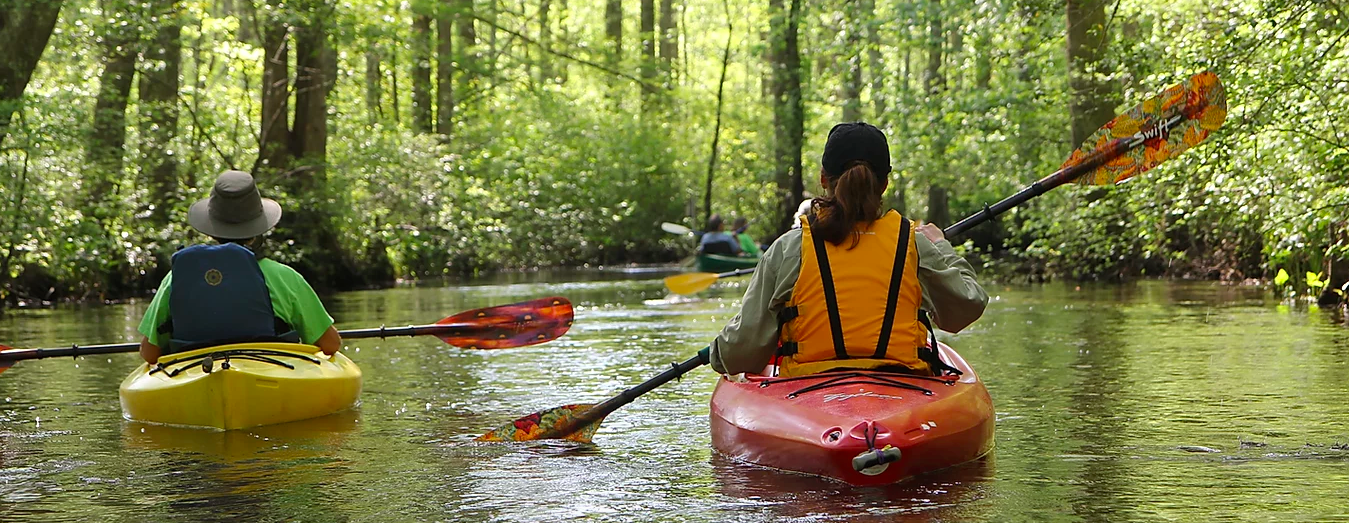“The Dragon wilderness is a totally unique ecosystem that was even ranked second in ecological significance among 232 areas researched by the Smithsonian.”
Looking for a place, even in this modern world, that feels untouched? That’s as intact today as it was thousands of years ago? That’s considered an ecological masterpiece?
If you’re on the Middle Peninsula in rural coastal Virginia, you don’t have to look far.
You just have to head to Dragon Run.
What is it?
Dragon Run is a brackish stream that begins in Essex County and drains at the bottom in Gloucester County, making it wholly unique to the Middle Peninsula.
The stream itself winds and twists due to its formation from sub-level springs and adjacent swamplands.
What makes the stream special is how generally untouched it is.
Its ecosystem is totally unique and visiting it is a bit like stepping back in time.
History and Significance
At the end of the last Ice Age, the Piankatank River drained in the Susquehanna. As the glaciers melted, this region was flooded, turning a great deal of the Susquehanna into the Chesapeake Bay. The lower flooded mouth section of the Piankatank became what’s now known as Dragon Run Swamp.
The flat landscape that continues for 40 miles continually formed over millions of years. Accumulated eroded sediments as well as natural erosion of the region led to the swamp looking how it did both thousands of years ago and today. Tannins, which are brown/black biomolecules, thrive on dead cypress leaves and other natural decay creating the blackwater swamp.
The Dragon wilderness is a totally unique ecosystem that was even ranked second in ecological significance among 232 areas researched by the Smithsonian.
The main reason that Dragon Run is as pristine and untouched is largely attributed to its remoteness.
The Run is crossed by highway bridges, yes, but most put-in locations for paddlers or fishermen require backwoods marches into dense forest. Because this many millions-of-years-old swamp has been protected, its ecosystem is almost identical to how it would have been back in time.
Fishing and Paddling
Dragon Run has two main sections – an upper and lower area.
The upper portion is more swamp like, complete with huge cypress trees, blackwater, and flooded wood. The area is beautiful, however, because the region is as natural as can be, that can sometimes cause some extra obstacles that may not arise in a more regulated paddling trail. Local beavers are known to create dams and logjams that can encumber progress. Early spring, then, becomes the best time to paddle Dragon Run because of the high-water levels that allow for better passage.
What’s great for fishermen is that they will find the Upper Dragon Run to have the exact same variety and diversity of species as their grandfather (and his grandfather before him, for that matter) experienced. Varieties include, among others, largemouth bass, warmouth, herrings, and shad.
The lower Dragon Run is quite like the upper Dragon Run, except with differing fish species and slightly more open spaces. Migratory species such as herring and striped bass can be found here due to the proximity to the Chesapeake Bay. The very bottom section of Dragon Run feeds into the Piankatank River where varieties of fresh and saltwater fishes can be tracked.
If just paddling is what you want, then you’re in luck. The entire run is free to paddle and, for the most part, is fairly beginner friendly as no rapids can be found.
Wide river channels, campsite rest stops along the way, and sights to see make it a fun trip for anyone.
Be sure to look out for eagles, beavers, and the beautifully enormous bald cypress trees that litter the swamplands.
Why Dragon Run?
Dragon Run is living natural history. There are few places in the entire country, let alone Virginia, that offer such an incredible (and free!) opportunity to see a piece of untouched living history.
Photo courtesy of Friends of Dragon Run.
